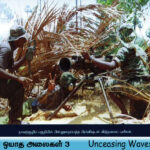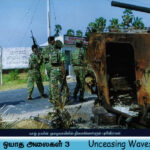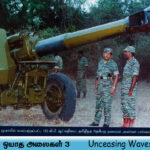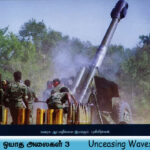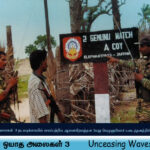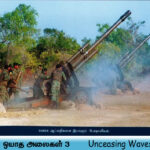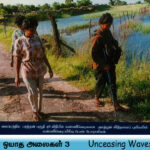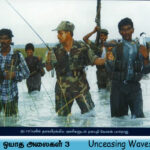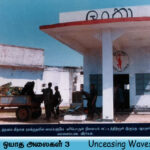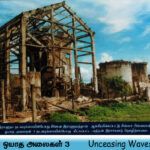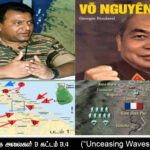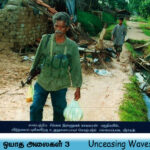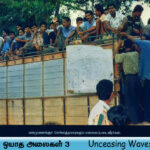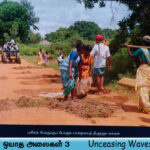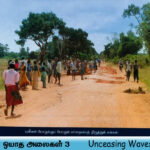

“Unceasing Waves 3” – Warfare Study Article 3

Comparison between the LTTE’s relentless Waves 3 (Phase 3, 4) and Viet Minh’s Battle of Dien Bien Phu in Vietnam
– Warfare Study Article 3
You know that French domination ended in 1954 with the “Viet Minh Battle of Dien Bien Phu” against the French forces stationed in Vienna.
Warfare Study researchers routinely refer to the “Battle of Dien Bien Phu” as one of the most important battles in the history of world warfare.
Over the past few months, I had written two articles entitled “Leader Prabhakaran and Other Revolutionaries – Brief Comparison”
I had mentioned that the national leader Prabhakaran was one step ahead of the other revolutionaries. I explained by comparison that the LTTE had achieved one step ahead of other revolutionaries in the strength of the target, despite the difficulty of the target.
I have written this post to explain to you more deeply that the LTTE’s fighting power is one step ahead of other revolutionary forces.
As you read this post you will also be compelled to read the “Leaves of the Tiger – “Unceasing Waves 3” (Phase 3, 4) – Warfare Study (Articles 1, 2) that I wrote.
The reason is that in both articles, the “Unceasing Waves 3” of the LTTE (Phase 3,4) are examined in detail.
I have abbreviated “Unceasing Waves 3” (Phase 3, Phase 4) as the English translation of “Unceasing Waves 3” (Phase 3, 4) for convenience (UW3 -P3, P4) in some places.
Let me first summarize the warfare information about the “Battle of Dien Bien Phu” first for the warfare comparison.
Background of “Battle of Dien Bien Phu”
In May 1953, General Henri Navarre assumes command of French Union forces in the Indochina region of France. He is preparing a plan to completely suppress the Viet Minh movement in Vietnam.
That operation is called “OPERATION CASTOR”.
Goal of “OPERATION CASTOR”
According to the plan, it was decided to set up a French military base on Viet Minh-controlled territory. That French military base is basically a trap created to destroy Viet Minh fighters.
How is that?
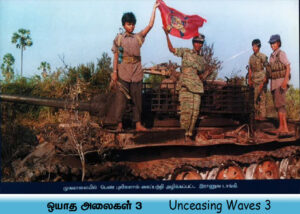
Thus inciting Viet Minh fighters to attack that base by setting up a military base.
Why provoke Viet Minh fighters to attack that site?
The reason was that the French army had superior firepower (Superior Firepower), set up a large military base in a wide area, provoked Viet Minh to attack that base, and then through their Superior Firepower take over the Viet Minh movement. General Henri Navarre had predicted that the vast majority of the movement would be destroyed.
Provisions of the “OPERATION CASTOR”
Based on the above goal, the French army began its moves.
Dien Bien Phu was chosen as the site for the military base.
The Dien Bien Phu area was 320 km from Hanoi, the most important base of the French army.
On 20/11/1953, 1800 paratroopers were landed by the French Army during “Operation Airborne” in the village of Dien Bien Phu. They are basically a spearhead force that acts as a front line on the battlefield and breaks down the enemy.
This paratroopers force immediately took control of the Dien Bien Phu area. Following that, the other brigades began to descend. Two runways were immediately created to ensure a supply route. (Two airfields were quickly built to ensure a supply link.)
Colonel Christian de Castries was responsible for this site.
The base was strengthened to 15,000 troops, 60 heavy and medium artillery pieces, 10 M24 Chaffees tanks and 6 napalm-armed Bearcat Fighter aircraft.
9 defensive boxes were set up as small mini camps around the site. The names of those small mini camps are as follows:
Eliane, Claudine, Huguette, Francoise, Dominique, Anne Marie, Gabrielle, Beatrice, Isabelle.
Now the French military base was ready with strong fire and adequate manpower. After that Viet Minh waited for months in anticipation of the attack.
According to General Henri Navarre’s estimate, Vo Nguyen Giap, commander of the Viet Minh movement, thought he could mobilize as many as two divisional fighters. A division brigade consists of 10000-15000 troops.
However, the preparations for the Viet Minh movement were different from expected.
Preparations for the Viet Minh Movement
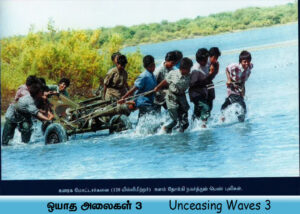
After the end of the Korean War in July 1953, the Chinese government began secretly supplying heavy weapons to the Viet Minh movement.
The Viet Minh movement acquired light and medium field artillery, anti-aircraft guns, and rocket launchers through China. Contrary to French expectations, General Vo Nguyen Giap moved four divisional fighters to the Dien Bien Phu area. The Viet Minh movement had nearly 200 artillery pieces. This is three times more than the 60 artillery pieces of the French army.
They set up tunnels in the mountains not far from the Dien Bien Phu military base and kept long-distance artillery towards the military base. Only the tip of the artillery shells were protruding.
“Battle of Dien Bien Phu” started
On 13/3/1954, on the orders of General Vo Nguyen Giap, Viet Minh militants launched an attack on a military base. The Beatrice defensive box was captured after the attack began. This defensive box is not a military base. They are mini camp sized. Two days later Gabrielle fell. Then came Anne Marie.
However, more than 2,500 Viet Minh fighters were killed in the initial attack. General Vo Nguyen Giap then switched to siege tactics for the next ten days. Then again, on 30/3/1954 the attack of the artillery began.
hen Dominique and Francoise fell.
Nevertheless, casualties on the Viet Minh side continued to rise. Again, General Vo Nguyen Giap had to bring in more troops. Prior to May 1, he was able to mobilize 50,000 fighters around the Dien Bien Phu base. Exactly on 7/5/1954, the entire Dien Bien Phu site also fell into the hands of Viet Minh.
Next let’s analyze the “Battle of Dien Bien Phu” with a warfare view.
(Fire Power)
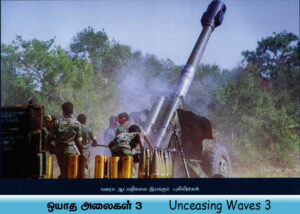
General Henri Navarre devised his plan to provoke Viet Minh to attack and destroy Viet Minh’s large force based on his Superior Firepower. The foundation of this “OPERATION CASTOR” is the Superior Firepower of the French Regiment.
He devised a plan to lure the Viet Minh into a PITCHED BATTLE, in which his supposedly superior firepower would annihilate GIAP’s guerrillas. The foundation of this “OPERATION CASTOR” has been shattered as Viet Minh with the help of China has increased its firing power over France.
Viet Minh – about 200 artillery, anti-aircraft guns. France- 60 heavy and medium artillery.
Manpower
The battalion at the French military base was a maximum of 15,000, including a significant number of non-combatant workers. France deployed about 4300 troops by parachute shortly after the start of the war. So all in all, the French army could end up as 15000. On the Viet Minh side, I mentioned above about the loss of a few thousand fighters in the initial phase of the offensive. But even after the casualties, historical records show that there were more than 50,000 militants during the final offensive in May.
This clearly shows that Viet Minh’s force was almost four times larger than that of the French army.
Next Historical Minimum Planning Ratios
I have already described this in Article 1. According to the Historical Minimum Planning Ratios, when the enemy takes defensive action, the number of forces attacking those positions must be at least three times as long as they are well prepared and fortified.
According to these Historical Minimum Planning Ratios, Viet Minh’s fighters who attacked the French army were almost four times as large as they were from the moment the attack began until the final moment.
After losing several thousand Viet Minh fighters in the initial phase of the attack, General Vo Nguyen Giap was able to bring in more troops.
“The guerrillas’ loses were enormous, and GIAP once more drew back to reinforce and regroup his forces. By 1 May, he had assembled 50,000 men around Dien Bien Phu.”
(From “The Great Battlefields of the World” by John Macdonald)
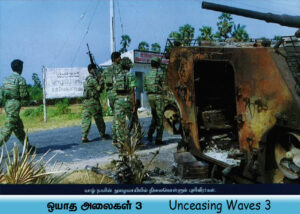
Force Ratio
I have elaborated on this Force Ratio in the first two articles of this series. Read it. It is easy to see from the above data that the Force Ratio is favorable for Viet Minh fighters. Let me illustrate this with an even stronger example. That is the Casualty Exchange Ratio.
What is the Casualty Exchange Ratio?
It points to the death toll in the war between the two sides. Proportional account of the number of casualties on the enemy side against the casualties of one of us. I have explained about this Casualty Exchange Ratio in detail in Article 2 of this series.
The loss of Viet Minh fighters in “Indochina War 1” was far greater than the loss of French troops. According to the Casualty Exchange Ratio, although the loss of Viet Minh fighters was high it did not cause major damage militarily. The reason is that the Force Ratio has always been in their favor many times over.
This was stated by Commander Vo Nguyen Giap in an interview.
“No other wars for national liberation were as fierce or caused as many losses as this war,” GIAP told the Associated Press in 2005 in one of his last-known interviews with foreign media on the eve of the 30th anniversary of the fall of Saigon, the former South Vietnamese capital.
“But we still fought because for Vietnam, nothing is more precious than independence and freedom,” he said, repeating a famous quote by Ho Chi Minh.
I would like to post here a comment made by a US Army Commander in this regard. That comment was about the loss of militants (Viet Minh & Viet Cong) led by General Vo Nguyen Giap in both “Indochina Wars”.
While some, such as the American journalist Stanley Karnow, regarded him as a strategist in the mold of Wellington, others, including the US general William Westmorland, believed his success was down to his ruthlessness.
Indeed, Westmorland complained to Karnow: “Any American commander who took the same vast losses as General Giap would have been sacked overnight.”
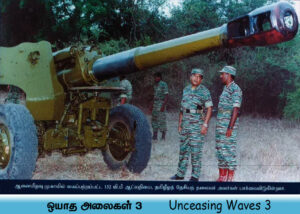
The reason for quoting US Army Commander William Westmorland’s criticism here is to make it clear that the loss of Viet Minh fighters was high. The Viet Minh fighters were able to win the war, especially because they were against the militants according to the Casualty Exchange Ratio and their Force Ratio was many times more favorable.
In addition, I do not want to flatter the personality of General Vo Nguyen Giap, considered one of the most influential commanders of the 20th century, with the criticism of an army commander.
Next Logistics
Dien Bien Phu is nothing like backdoor assistance to the military base. It is an area that can only receive assistance from the entire Air Force. Two runways were created to ensure a supply route for it.
I mentioned above that the Dien Bien Phu military base was 320 km from Hanoi, the most important base of the French army.
After Viet Minh fighters launched an attack on the Dien Bien Phu military base, the airstrip was damaged in the attack. Everything was then unloaded by air force parachute.
Viet Minh artillery fire had destroyed the airstrip, so that all supplies and reinforcements for the French garrison had to be parachuted in.
(From “Great Battlefields of the World” – John Macdonald)
A comparison between the LTTE’s “Unceasing Waves 3” (Phase3, 4) and Viet Minh’s Battle of Dien Bien Phu.
In this comparison I have listed the warfare factors that were favorable to Viet Minh fighters. I have also listed the same warfare factors that were against the LTTE.
The main purpose of this article is to establish that the LTTE did unimaginable military feats in the world´s warfare history even though when everything that was in positive aspects for other revolutionaries was against the LTTE.
The next objective is to think of passing on the historical truth with this warfare vision to the next generation.
And all revolutionaries deserve admiration.
I have given below a very brief comparison of this warfare in terms of number. This is because the detailed explanations related to this are explained in detail in Article 1, 2 of this series.
Manpower
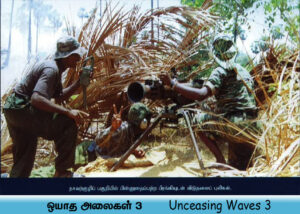
“Battle of Dien Bien Phu”
French troops numbered nearly 15000.
The number of Viet Minh fighters is over 50000.
“Unceasing Waves 3” (Phase 3, Phase 4)
The number of Sri Lankan soldiers in the theater of war in Jaffna was at least 40,000. However, the Sri Lankan military was torn in two by the national leader Prabhakaran’s deception warfare move.
After the breakup, the Sri Lankan army took part was only 25000 during the “Unceasing Waves 3”. The maximum number of fighters assigned by the LTTE does not exceed 7000. (This is an assumption only. A detailed explanation is given in Article 1)
Fire Power
“Battle of Dien Bien Phu”
The firing of the French army.
Number of heavy and medium artillery 60.
Number of M24 Chaffees tanks 10.
Number of napalm-armed Bearcat Fighter aircraft 6.
The Viet Minh Movement firing.
About 200 artillery, anti-aircraft guns.
“Unceasing Waves 3” (Phase 3, Phase 4)
LTTE firing. Three artillery pieces, including two 122 mm howitzers, and only about 10 of the 120 mm mortars. However, in (UW3 -P3, P4) only the artillery of the Sri Lankan army destroyed by the LTTE exceeded 30. And at least 6 Main Battle Tanks (MBT) were completely destroyed. A further 10 tanks were severely damaged. Also the Mi-24 attack helicopter was shot down.
Listed above (UW3 -P3, P4) is the firing range of the Sri Lankan Army that was destroyed by the LTTE during the war. At least 150 artillery pieces were in the possession of the Sri Lankan Army or could be moved to the theater of war in Jaffna. The number of combat aircraft and attack helicopters in the Sri Lanka Air Force is at least 30.
Logistics (backend help)
As mentioned above you may know that the Dien Bien Phu military base was a base that relied solely on the Air Force for additional forces and supplies, without the aid of any rear bases. But Elephant Pass is not a single site. It is a package supports many similar military bases. That is why I used the phrase ‘set of military bases’ in my article 1.
This ‘set of military bases’ includes the Elephant Base, the Operational Base, the Pallai Army Base with a large number of artillery bases, the Army Base under the Sheet of the 53rd Division of the US Special Trained Commando Team, the Army and Naval Base, the Broadway, and the Umayalpuram Base in the South. In the next tier there were several army camps behind them, and in the next tier there were hundreds of mini army camps all of them as a bulwark. All these highways, army camps, and mini-camps were intertwined a few kilometers from each other.
(If you want to know all the bases, military camps and all the mini camps included in this ‘set of military bases’, you must read Article 1.) Eleanor is not just a single site like Dien Bien Phu, it is a collection of military bases. All the military bases I mentioned above (UW3 -P3, P4) were completely destroyed and captured during the war.
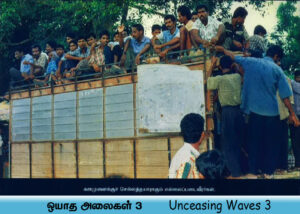
Next Historical Minimum Planning Ratios
According to these Historical Minimum Planning Ratios, to attack the well-prepared and fortified military base of Dien Bien Phu, Viet Minh’s manpower was almost quadrupled from the moment the attack began until the final moment.
But in this battle (UW3 -P3, P4), the number of Sri Lankan soldiers on the set of large, well-prepared and fortified military bases was four times the number of LTTE cadres who carried out the attack. That is, the Sri Lankan army is at least 25000. On the contrary, the maximum number of LTTE cadres is 7000.
Assistance from the Sovereign State
During the “Battle of Dien Bien Phu”, China’s assistance was the main reason why the Viet Minh fighters’ fire power became stronger than the French brigade. This is possible only with the help of heavy weapons provided by China.
However, they have not had the help of another sovereign state in the LTTE’s history of armed struggle. (India’s assistance received before 1987 is in no way related to the battle (UW3 -P3, P4).)
Fight between the LTTE (UW3 -P3, P4) and Viet Minh’s “Battle of Dien Bien Phu”.
One thing you can clearly see is that you have read the comparison list so far. You can clearly see that all the factors that determine the success or failure of the war, such as personnel, firepower, logistics, and the help of the sovereign state, were in favor of the Viet Minh fighters in the “Battle of Dien Bien Phu”, while similar factors (UW3 -P3, P4) were against the LTTE in the battle.
The number of French soldiers killed in the “Battle of Dien Bien Phu” is about 2500. At the same time the loss of Viet Minh fighters is more than 4000.
“Unceasing Waves 3” (UW Phase 3, Phase 4) in battle.
The death toll from the Sri Lankan military is at least 3,000. But the number of LTTE fighters killed is less than 500.
During the “Battle of Dien Bien Phu” here, the surrendered French regiment was not included.
The purpose of this article is to explain to you with a view to the warfare study and as stated earlier: Even though the positive things that other revolutionaries had in the history of the world were against the LTTE, the LTTE achieved unimaginable military achievements!
- Jayakanth
